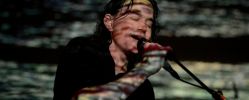
BREAKING WEATHER: Rainbow In Sky (UPDATED)

PHOTO: Los Angeles, 12/7/09, 3:05 pm.
Where were you when the rainbow struck?
Science lesson from Wikipedia:
The light is first refracted as it enters the surface of the raindrop, reflected off the back of the drop, and again refracted as it leaves the drop. The overall effect is that the incoming light is reflected back over a wide range of angles, with the most intense light at an angle of 40°–42°. The angle is independent of the size of the drop, but does depend on its refractive index. Seawater has a higher refractive index than rain water, so the radius of a ’rainbow’ in sea spray is smaller than a true rainbow. This is visible to the naked eye by a misalignment of these bows. The amount by which light is refracted depends upon its wavelength, and hence its colour. Blue light (shorter wavelength) is refracted at a greater angle than red light, but due to the reflection of light rays from the back of the droplet, the blue light emerges from the droplet at a smaller angle to the original incident white light ray than the red light. You may then think it is strange that the pattern of colours in a rainbow has red on the outside of the arc and blue on the inside. However, when we examine this issue more closely, we realise that if the red light from one droplet is seen by an observer, then the blue light from that droplet will not be seen because it must be on a different path from the red light: a path which is not incident with the observer’s eyes. The blue light seen in this rainbow will therefore come from a different droplet, which must be below that whose red light can be observed.
UPDATE: Gone now.











